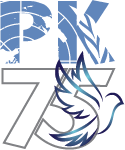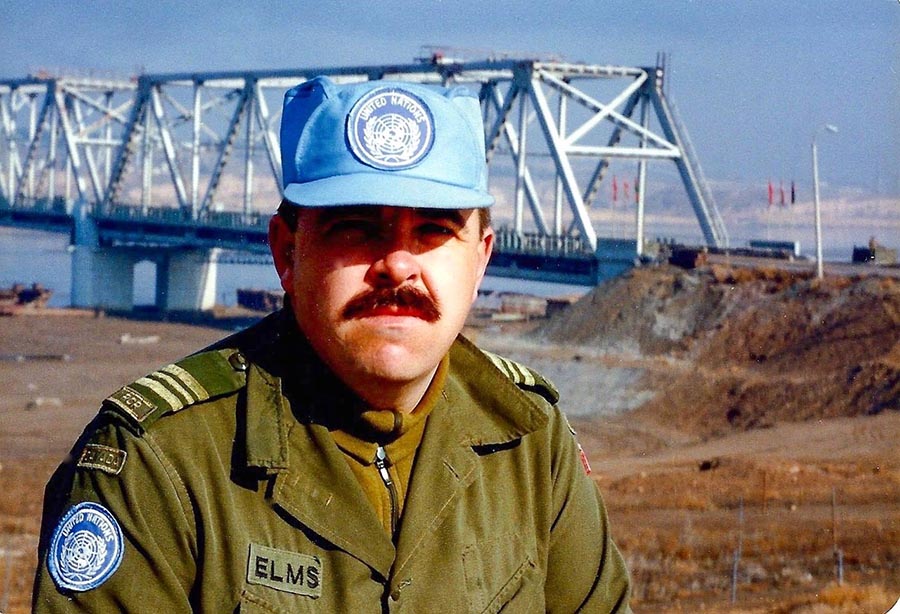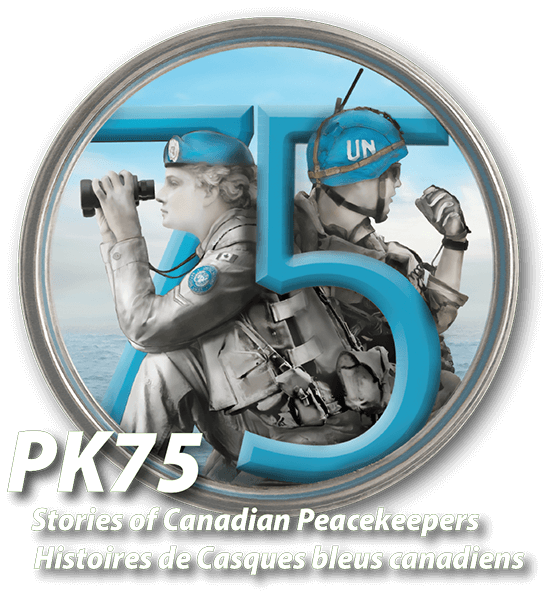

Toronto, ON, Canada
R.G. (Geordie) Elms
Current Location: Hamilton, ON, Canada
In the Canadian Army of the 1970s, opportunities for overseas service were generally limited to either deployment on UN peacekeeping duty in Cyprus, or with our contribution to NATO forces in Germany. I had been fortunate to experience both when, in July 1983, I was posted to the United Nations Truce Supervisory Organization (UNTSO) as a UN Military Observer (UNMO) with Observer Group Beirut (OGB). It was created following Israel’s invasion of Lebanon in 1982. When I arrived, it included four Canadians.
OGB HQ was located in the Hazmieh area of East Beirut. Three patrol routes covered the areas of the city during the day, and one at night covered the entire city between midnight and 0800 Hrs. By September 1983, maintaining patrols in the western and southern areas of the city became problematic, as the security situation deteriorated. Checkpoints along the “Green Line” split the city in half and could be thrown up without notice, forcing our patrols to negotiate through checkpoints, or to find an alternate way back to Hazmieh. On 31 August, the Israelis departed.
On 19 September 1983, ships of the U.S. Sixth Fleet arrived off the coast of Beirut to provide supporting fire to the Lebanese Armed Forces brigade fighting in the Chouf mountains. On the morning of the 25th, I went out onto my apartment balcony in West Beirut to find the USS New Jersey had arrived off the coast with her 16 inch guns ready to fire into the Chouf, if needed; they were not brought into action until 14 December.
On the night of 22 October, having completed the night patrol, my French colleague and I returned to OGB HQ as the standby team. At 0622 hrs we were awakened by a large rolling boom that shook Beirut. A huge black cloud began billowing up over the area of Beirut International Airport (BIA). About three minutes later, a second blast hit. It was in the area of the old racecourse where the French MNF contingent was based. It was bedlam. The two blasts killed 258 U.S. Marines and 41 French Parachutists.
On the evening of 5 February 1984, several UNMOs had dinner in our apartment in the Bain-Militaire area of West Beirut. By this time tensions had increased to where people no longer went out after dark unless on patrol. In the local area for a few days, we observed small groups of young Druze men. Canadian UNMO, Major Leo O’Donovan, went downstairs where a number of them were leaning on his car and asked them to keep an eye on it. They said they would. The next morning it was gone. My wife Shirley and I left Beirut for holidays in Egypt with an Australian UNMO and his wife. As it turned out, we left on the last plane out of BIA, as rounds began to land on the outer perimeter and taxiway. The “6 February Intifada” that saw the Shia Amal and Druze forces defeat the LAF and take control of West Beirut had begun. Eventually, we ended up in Cyprus. By then it had been decided that I would be extended for a second year, so I returned to OGB in the third week of February and Shirley remained in Damascus until my next station was confirmed. OGB began a brief reconstitution to replace vehicles and equipment lost and damaged. Its personnel complement would also be reduced and our Chief OGB, who was a French Foreign Legion officer, made that a priority ensuring that those who were exhausted and in need of a change were sent on leave and to other posts. He was fearless, led from the front, and was very loyal to those who served under him during the “dark days” in Beirut. When he returned to France in 1985, he took the seven of us still serving with UNTSO to dinner and presented each with a personal memento.
In May 1984, I was posted to UNTSO HQ to be the Mission Information Officer. On arrival, I met our new Senior Canadian Observer, Lieutenant-Colonel Don Ethell. Over the next twenty-five years, I worked for him three times and he became a mentor and friend. A soldiers’ soldier, I have never worked with or for a finer man. Of 19 awards of the Chief of Defence Staff Commendations in 1985, seven were to the Canadian UNMOs who served with OGB in 1983–1984. I frequently think of those times in Beirut.
Biography
Geordie Elms was born in Toronto (ON). In 1967, he followed his grandfather and father into the 48th Highlanders of Canada, as a piper. In 1972, he was commissioned under the Reserve Officer University Training Plan (ROUTP) and, on 13 December 1974, Lieutenant Elms joined 3rd Battalion, The Royal Canadian Regiment. For the next 36 years, he went on to serve on regimental duty in Petawawa, Germany, Winnipeg, and Gagetown, and on operations/peacekeeping duties in Cyprus (1976–1977), Lebanon and Israel (1983–1985), Afghanistan and Pakistan (1988–1989) and the Former-Yugoslavia (1992–1993). He served at NDHQ in the Directorate of Peacekeeping Operations (1989 to 92) and as the Infantry Officers Career Manager (1997–2000). In 2000, he was appointed Commanding Officer, the Argyll and Sutherland Highlanders of Canada. He served as the Canadian Defence Advisor/Attaché to Pakistan and Afghanistan (2003–2006), and then established Canadian Defence Attaché Office Kabul (2006–2007). His service in Southwest Asia was recognized with the award of the Meritorious Service Medal (MSM). Colonel Elms’ final appointment was as Canadian Defence Attaché to Israel (2008–10). On 13 December 2010 he retired and, with his wife Shirley, returned to Hamilton. In retirement, he is active with the Last Post Fund, Commissionaires Hamilton Division, and several charities that aid veterans.

Shirley Elms with Palestinian refugee children inside the stadium adjacent to the Sabra and Shatila refugee camps (October 1983).

Maj Geordie Elms on UNGOMAP OP Hayratan (January 1989).


